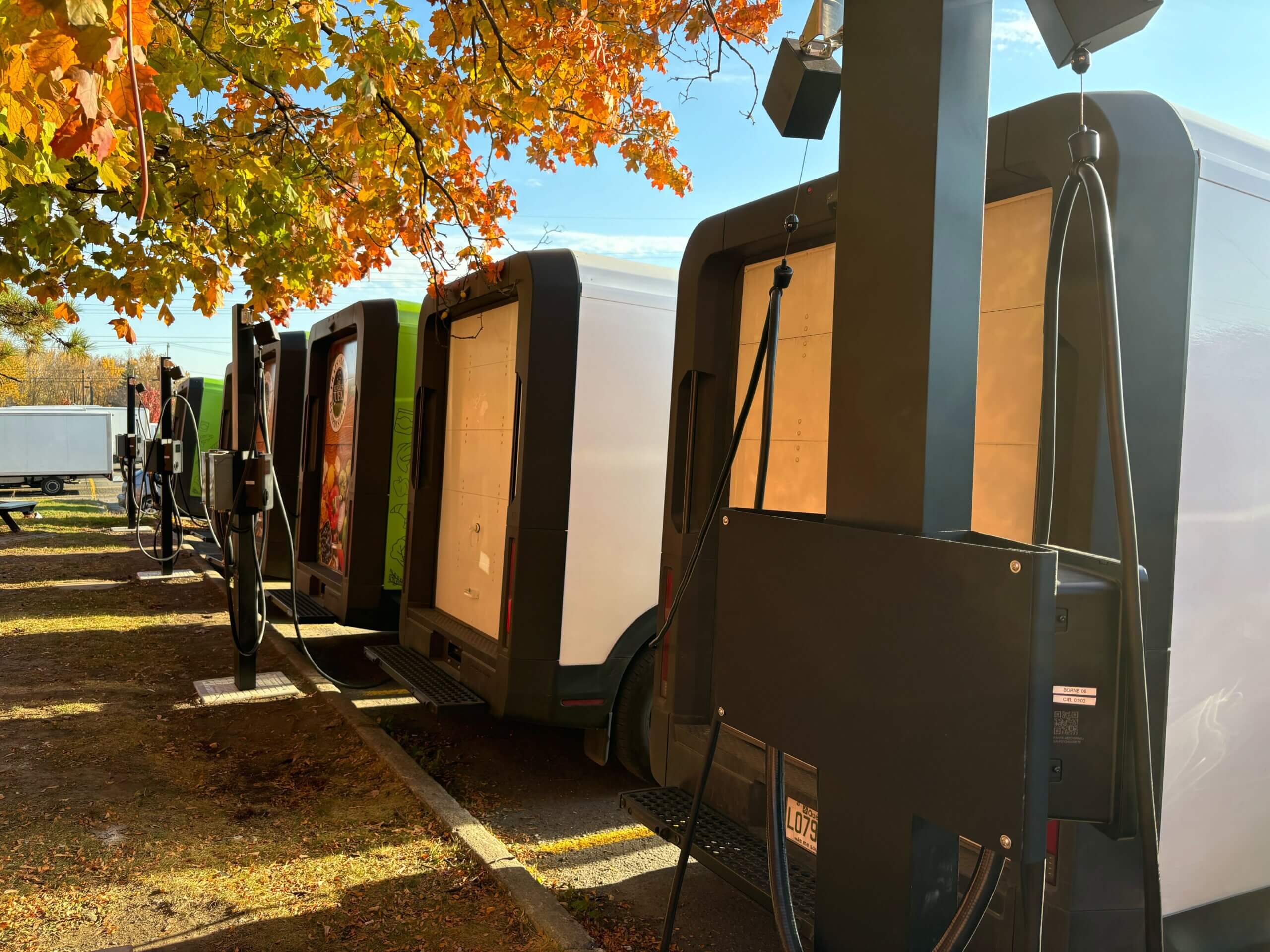In today’s logistics landscape, sustainability is no longer just a buzzword. As Forbes notes, it’s a business imperative. Companies that embrace sustainability as part of their core strategy are better positioned for long-term growth, resilience, and customer loyalty. Across the transportation and delivery sectors, this shift is clear: organizations are rethinking how they move goods, not only to meet regulatory targets but also to stay competitive in a market where shippers and consumers expect low-carbon operations.
For operators and fleet managers, the good news is that switching to sustainable last-mile delivery does not have to strain budgets. Electrifying your fleet is one of the smartest strategies to reduce costs, boost efficiency, improve driver satisfaction, and meet the expectations of both regulators and customers.
The Challenges of Last-Mile Delivery
Investing in electric vehicles (EVs) isn’t only about compliance. It’s about adopting the technologies today that will help you win business tomorrow.
Last-mile delivery, moving goods from a local hub or fulfillment center to the customer’s doorstep, is the most expensive and environmentally impactful segment of logistics. It represents more than 50 percent of total shipping costs globally.
The demand for fast shipping options like same-day and two-day delivery only adds to complexity. At the same time, consumers increasingly want greener deliveries. In fact, 60% of customers prefer companies with lower carbon footprints.
For fleet managers, this means sustainability isn’t a “nice to have”. It’s a competitive advantage.
The Future of Last-Mile Delivery Is Electric
Canada’s zero-emission vehicle (ZEV) market (the regulatory category defined by Transport Canada that includes battery-electric vehicles (EVs) as well as hydrogen fuel-cell vehicles) continues to expand. In Q2 2025, 9.2% of new vehicle registrations were electric. With supportive regulations, infrastructure investment, and rising consumer demand, EV adoption is maintaining steady momentum.
For last-mile fleets, EVs deliver a powerful combination: lower operating costs, compliance with evolving clean fuel standards, and improved air quality in urban centers. They also strengthen brand image with shippers and retailers facing growing pressure to meet sustainability targets. In addition, EVs operate much more quietly than diesel vehicles, helping to reduce noise pollution and create calmer urban soundscapes.
1. Lower Transportation Costs
While upfront EV prices remain higher than diesel alternatives, the total cost of ownership (TCO) increasingly tilts in favor of electric.
- The Vincentric Canadian EV Cost of Ownership Analysis (2025) confirms that EVs deliver substantial savings over five years thanks to reduced fuel and maintenance expenses.
- EVs have fewer moving parts, require no oil changes, and benefit from regenerative braking, which extends brake life.
- Electricity prices tend to be more stable than fossil fuel markets, helping fleets forecast operating costs with greater certainty.
When combined with federal and provincial incentives, as well as carbon credit monetization, many fleets are finding that monthly lease payments for EVs are already competitive with or lower than their current fuel and maintenance bills for ICE vans.
2. Better Operational Efficiency
Electrification is not just about swapping a diesel engine for a battery. It’s about unlocking smarter, data-driven operations. Modern EVs generate massive amounts of information from sensors, telematics, and charging systems. When that data is harnessed through the right tools and expertise, it provides deep, actionable insights that improve both performance and profitability.
With integrated fleet and charging management systems, operators can:
- Monitor real-time energy use and optimize charging schedules to reduce utility costs
- Track greenhouse gas (GHG) reductions and monetize carbon credits where eligible
- Analyze routes and driver behavior to cut mileage and boost productivity
Solutions like those offered by 7Gen simplify how this data is collected, interpreted, and acted upon. By consolidating vehicle, charger, and energy insights into a single platform, fleet managers can make faster, data-driven decisions that reduce costs and support sustainability goals.
These insights go beyond operational efficiency. They provide verified data that shippers increasingly require when reporting Scope 3 emissions. For fleet operators, this transparency becomes a competitive advantage when partnering with retailers focused on sustainability.
3. Compliance and Clean Air Benefits
Governments worldwide continue to tighten emissions regulations to align with the Paris Agreement. In Canada, programs such as the Clean Fuel Regulations and British Columbia’s Low Carbon Fuel Standard (LCFS) are creating direct financial value for fleets that go electric.
At the same time, EVs eliminate tailpipe emissions, which improves air quality in cities. This matters when most urban residents live within 300 meters of major roadways, where air pollution can be up to 300% higher than in less congested areas.
By deploying EVs, fleets not only meet regulations, they also demonstrate a measurable contribution to healthier communities.
4. Reducing Noise Pollution in Urban Areas
Beyond cutting emissions, EV fleets also contribute to quieter, more livable cities. Traditional delivery vehicles powered by diesel or gasoline engines generate significant noise from both engines and braking systems. Electric vehicles, by contrast, operate almost silently, especially at low speeds, reducing overall noise pollution and improving urban quality of life.
This difference is particularly valuable in dense neighborhoods where delivery routes overlap with residential zones. As GEODIS notes, EV adoption is already transforming urban soundscapes, making streets calmer and safer for pedestrians and cyclists. In some cases, quieter operations also allow fleets to extend delivery hours, easing daytime congestion while respecting community noise limits.
5. Building a Sustainable Advantage
Sustainability is now a market differentiator. According to Deloitte’s Global Sustainability Study 2025, 43% of consumers are more likely to choose retailers offering sustainable delivery options.
By putting sustainability at the forefront, fleets can win contracts with large e-commerce retailers and logistics providers focused on Environmental, Social, and Governance (ESG) performance. With more than one-third of shipping RFPs now requesting EV services, it pays to make the switch.
Overcoming Barriers to Zero-Emission Vehicles
Despite the benefits, some fleet managers remain cautious due to concerns about range, infrastructure, and upfront costs. Yet these barriers are being overcome quickly:
- Range anxiety: Advances in battery technology now enable many EVs to cover 200+ miles on a single charge, perfectly suited for most urban and suburban routes.
- Charging infrastructure: Canada’s charging network is expanding rapidly, with forecasts showing major growth through 2040. Owning chargers can also be more cost-effective than relying on public stations.
- Medium- and heavy-duty fleets: Transitioning larger vehicles comes with added challenges. The 2025 Zero-Emission MHDV Ecosystem Analysis highlights the need for workforce training and depot upgrades, but also shows growing support from federal and provincial programs.
- Upfront costs: Flexible financing and lease-to-own models convert CAPEX into predictable OPEX, making EV adoption accessible even for budget-constrained fleets. Add in rebates and tax credits, and the business case becomes even stronger.
Steps to Transition to Sustainable Last-Mile Delivery
Electrifying your last-mile fleet is a journey, and like any major transformation, it works best with a clear roadmap. Here are five practical steps that can help fleet managers move from planning to real-world results:
- Assess your fleet
Start by identifying which vehicles are due for replacement and run a total cost of ownership (TCO) analysis. This helps you understand where electrification will deliver the fastest payback. - Leverage incentives
Take advantage of every available program. Federal, provincial, and even municipal rebates and grants can offset much of the initial cost of EVs and charging infrastructure. - Plan infrastructure early
A site assessment can reveal whether your depots are ready for charging. Considering bundled solutions that combine vehicles and chargers under one agreement can simplify rollout and reduce risk. - Partner with experts
Work with EV specialists who can tailor solutions to your routes, payloads, and budget. Their expertise can help avoid costly missteps and speed up deployment. - Monitor and optimize
Once vehicles are on the road, use management software to track performance, report emissions, and even generate revenue through carbon credits where eligible. Continuous optimization ensures your fleet stays efficient and compliant as technology and policies evolve.
The Road Ahead
Switching to sustainable last-mile delivery isn’t just about compliance. It’s a powerful way to cut costs, reduce emissions, and strengthen your competitive position in an increasingly ESG-focused market.
With comprehensive solutions, from vehicle selection to charging setup, financial modeling, and operations, 7Gen helps take the guesswork out of electrification.
Ready to electrify your last-mile delivery fleet? Contact us today to see how we can support your transition.

